Diseases/Conditions
Aluminum in Vaccines Is an Autism Trigger: New Study
Autism is a perfect storm of genetics triggered by vaccine toxins. However, blaming the genes is like blaming a dry field for causing a fire. In autism, the spark that triggers the conflagration is usually aluminum in vaccines.
The debates about autism’s cause may be coming to an end. A new study cleverly uses statistical analyses on the Vaccine Adverse Events Reporting System (VAERS) database. It leaves little doubt that the primary issue is aluminum adjuvants in vaccines, with effects of acetaminophen (known as paracetamol in Europe), vaccine mercury, live attenuated vaccine microbes, and genetic susceptibility as linked factors.
Autism is a perfect storm of genetics triggered by vaccine toxins.
Study Overview
The study, “Empirical Data Confirm Autism Symptoms Related to Aluminum and Acetaminophen Exposure”1, finds and sorts out the interrelationships of the long suspected and debated factors of autism’s cause.
They found that a particular genetic inclination, an inability to detoxify some metals and other substances, is required, but that alone is not enough to trigger the condition.
Mercury alone, or in conjunction with aluminum adjuvanted vaccines, was likely a factor in many cases. However, there was an ongoing increase in the autism rate after most mercury was removed from children’s vaccines. That has often been used against people who advocate for vaccine choice, but it’s well explained by this study’s authors, Seneff, Davidson, and Liu.
A strong association of the MMR vaccine with autism and adverse events is both documented and explained.
The use of acetaminophen to reduce fever and inflammation caused by vaccines is shown to be a likely causative factor in autism.
However, the single most significant factor in causing autism is probably aluminum adjuvants. They may be a background cause in cases where mercury, MMR, or acetaminophen are the more immediate triggers.
Statistical Study of VAERS
Since the study relies on statistics, the first complaint will likely be that there are lies, damned lies, and statistics. While that’s true when the intent is to obscure, this study’s purpose is to elucidate. Furthermore, they assure accuracy by calculating and taking strong note of p-values, which are a means of determining the likelihood of achieving results by chance.
Over and over, their p-values are astoundingly low, meaning that the odds of getting the same results by chance are minuscule. Taken individually, that would tend to be very strong evidence of the study’s validity. Taken as a whole, these p-values are indicative of results that simply cannot be ignored—that do, in fact, indicate a near-perfect demonstration that aluminum is associated with autism and may trigger it.
Symptoms in Autism & Nonautism VAERS Groups
The authors found every VAERS report in which the word “autism” or “autistic” showed up. That came to 1,734 records (C1). They then took a random sample from the rest of the reports (approximately 340,000), exactly matching the ages with those of the C1 autism group, for a second group of records (C2).
They then did searches in these two groups of records for words that would likely be associated with autism. The first results are produced in Table 1. Quite clearly, you can see that there is a very close correlation between autism-related symptoms in reports of autism (column C1) and there are very few autism-related symptoms in nonautism VAERS reports. This, though, is just the beginning of the study—an indication that they’re on the right track.
MMR, Hep-B, & HiB
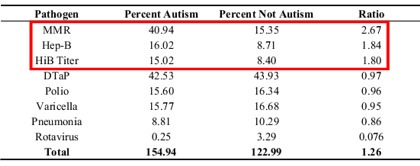
Table 2. MMR, Hep-B, HiB Titer Reports
Totals over 100% because several vaccinations are often administered.
Using a similar technique but instead searching for the vaccines associated with the reports, they found that VAERS reported 2.67 times more autism-associated cases than non-autism cases after the MMR. There were nearly double the number of VAERS reports associated with autism after Hep-B and HiB vaccines.
Currently, the MMR vaccine contains neither mercury nor aluminum. It does, however, utilize a live attenuated antigen. This results in fever, which is typically treated with acetaminophen. Studies have shown that children with autism are less capable of metabolizing acetaminophen.
The authors point out a major anomaly* in the disgraced Thorsen Denmark study that purports to disprove any connection between vaccines and autism. Large dose of vaccines are given shortly after 15 months. It would, therefore, be expected that the autism rate before 15 months would be noted to see if these vaccines are a trigger. However, Thorsen’s study lumped all autism cases into one age range, birth to 3 years.
*Gaia Health would be more inclined to refer to this as fraud, a clear attempt to cover up important data.
Why does this matter? Highly toxic aluminum is included in several vaccines given before 15 months, including Hep-B, Prevnar, and DTaP vaccines. Also, influenza vaccines in multidose vials still include Thimerosal (mercury), and these are given before age 15 months. Therefore, a large number of children who might have developed autism before the age of 15 months would not show up as vaccine-induced in the Thorsen study!
Now, let’s tie all this information together—the acetaminophen sensitivity in children with autism combined with the prevalence of both mercury- and aluminum-containing vaccines given to young children. Graph 1 shows the number of children with autism in VAERS, reported by year.
Notice that when mercury was first phased out of most vaccines in 1999, the rate of reported autism did, indeed, drop. However, the autism reports quickly increased in less than five years, until it was even higher than before. This is generally used to suggest that there’s no connection between autism and either the MMR vaccine or mercury. However, closer inspection demonstrates exactly the opposite.
Another change took place while mercury was being phased out of most vaccines. The aluminum load was increased—phased in as mercury was phased out!
Was this intentionally duplicitous, an attempt to give the impression that mercury couldn’t have induced autism? I’ll leave that up to the reader.
Table 2 reveals that children who were already sensitized by aluminum from earlier vaccines are far more likely to suffer adverse effects from the MMR vaccine, even though it doesn’t contain either mercury or aluminum. It does, though, result in fever—and fever is routinely treated with acetaminophen, a neurotoxin that children with a genetic predisposition to autism are unable to adequately detox. They are, therefore, more likely to suffer from acetaminophen-induced neurological symptoms, including autism.
Table 2 also reveals that the Hep-B vaccine, which is given at birth and two more times by six months of age, is almost twice as likely to result in VAERS reports of autism-like symptoms. It contains aluminum. Further, the HiB vaccine, which is routinely given in conjunction with several other vaccines, includes aluminum and also results in autism-like symptoms.
It is likely that children who have not yet been put over the edge into full-fledged autism may be pushed there by the use of acetaminophen to reduce fever from a strong inflammatory reaction to the MMR vaccine.
VAERS Reports Related to Aluminum Adjuvant
Table 3 addresses two issues: timing of reports (before or after 2000, when removal of mercury began) and whether the reported adverse effect related to a vaccine containing aluminum.
A search was done to find serious adverse effects between 1990 & 2000 (“C1 Before 2000″) and another on an age-matched group to find the same symptoms between 2000 & 2010 (“C2 After 2000″). You can quickly see by the enormously increased rate of reports that something happened after 2000 to resultin significantly more adverse reactions. Notice also the extremely low p-values, indicating that these results are significant virtually to the point of absolute assurance.
Seizures became 5½ time more common. There were 2⅔ times more deaths. Clearly, something was happening.
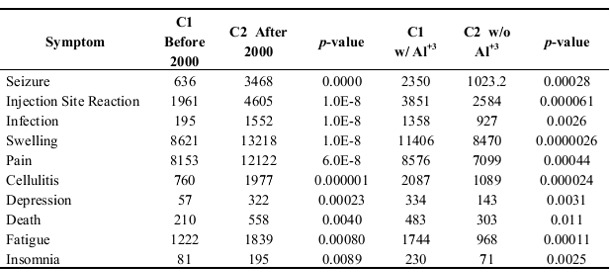
Table 3. Adverse Reactions Pre- and Post-2000 & With or Without Aluminum Adjuvant in Vaccine
C1 w/ Al+3 = with Aluminum Adjuvant. C1 w/o Al+3 = without Aluminum Adjuvant.
Each of these symptoms was then checked according to whether the aluminum adjuvant was in the vaccine being reported. The results are, again, highly significant. Almost 3 times as many seizures could be directly associated with aluminum adjuvants and almost 1⅔ times more deaths were associated with them.
The graph to the left shows the total number of adverse events associated with aluminum-containing vaccines for the years 1990-2010. The sudden drop-off starting in 2003 is likely associated with a workshop held to find ways to reduce aluminum in vaccines.
However, the sharp upward swing from 2009 to 2010 is very worrisome. The fact is that new vaccines are being added to the schedule inflicted on our children.
The Power of Numbers
The study did other analyses that further clarify associations and effects of:
- Aluminum adjuvants
- Mercury in thimerosal
- Live attenuated viruses in vaccinations – specifically the MMR vaccine
- Acetaminophen
- Genetic inclination
All of these are shown to be factors in the ongoing epidemic of autism, with a genetic distinction required, but alone not enough to trigger it. The primary trigger is aluminum in vaccine adjuvants, possibly aggravated by aluminum from other sources, such as the glass containers that hold vaccines. Mercury and acetaminophen may be enough on their own to trigger autism, but there can be little doubt that they also operate in an unholy partnership with aluminum.
How they all conspire is discussed in Aluminum Adjuvant Blasts Genetics to Create Autism, coming up shortly.
Source:
- Empirical Data Confirm Autism Symptoms Related to Aluminum and Acetaminophen Exposure, Stephanie Seneff, Robert M. Davidson, and Jingjing Liu. entropy, doi:10.3390/e14112227d
Tagged aluminum acetaminophen autism, aluminum adjuvant causes autism, aluminum mercury autism, aluminum paracetamol autism, autism, autism cause, autism vaccines, autism vaccines cause, big pharma, conventional medicine, mercury autism, mercury vaccines, modern medicine, science, thorsen denmark fraud, thorsen fraud, vaccine, vaccine aluminum autism, vaccines, vaers autism, vaers autism study, vaers database, vaers statistics

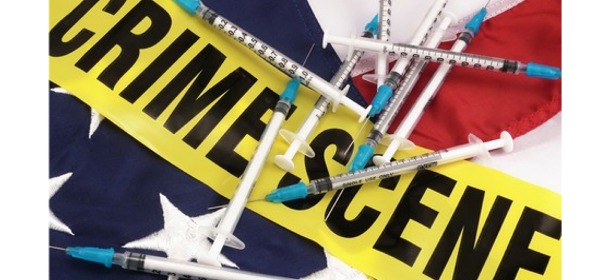

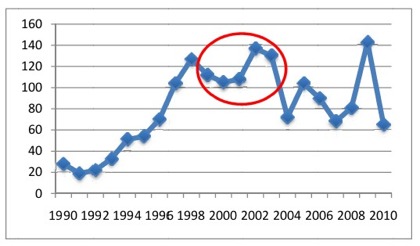
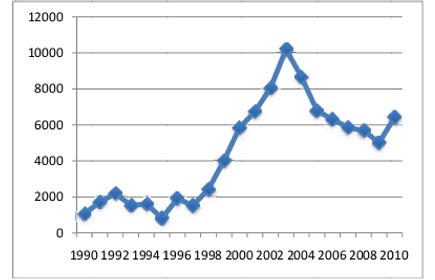













Pingback: Aluminum Adjuvant Blasts Genetics to Make AutismGaia Health
Pingback: Flu, Flu, Flu–what to do? « Dregs of the Future
Pingback: No Historical Benefit in Vaccines: Polish Study | Health Impact News
Pingback: No Historical Benefit in Vaccines: Polish Study – Waking Times : Waking Times
Pingback: No Historical Benefit in Vaccines: Polish Study | Daddy Fix
Pingback: » No Historical Benefit in Vaccines: Polish Study JoshPass.com
Pingback: No Historical Benefit in Vaccines: Polish Study | Spread The Info
Pingback: No Historical Benefit in Vaccines: Polish Study | …..Aaron's EnvironMental Corner…..
Pingback: cascading failure
Pingback: mouse click the next internet page
Pingback: similar webpage
Pingback: main page
Pingback: simply click the up coming webpage
Pingback: More Support
Pingback: This Internet page
Pingback: relevant webpage
Pingback: Visit
Pingback: please click the following website
Pingback: simply click the next document
Pingback: simply click the following website page
Pingback: visit the next internet site
Pingback: simply click the next document
Pingback: Read A great deal more
Pingback: mouse click the next web page
Pingback: Our site
Pingback: Suggested Web page
Pingback: Read the Full Guide
Pingback: Read the Full Post
Pingback: this website
Pingback: visit the next internet site
Pingback: visit the up coming document
Pingback: visit the next website page
Pingback: Read the Full Document
Pingback: Read the Full Piece of writing
Pingback: Recommended Studying
Pingback: relevant web page
Pingback: related web site
Pingback: relevant web site
Pingback: simply click the following page
Pingback: similar web page
Pingback: simply click the up coming internet page
Pingback: simply click the following web site
Pingback: stay with me
Pingback: This Resource site
Pingback: simply click the up coming post
Pingback: visit the following internet page
Pingback: visit the following website
Pingback: Our site
Pingback: Bonuses
Pingback: This Internet site
Pingback: please click the next web page
Pingback: Click On this site
Pingback: click the next internet site
Pingback: click the up coming internet site
Pingback: Click This Link
Pingback: Read the Full Write-up
Pingback: click through the next page
Pingback: click through the next website
Pingback: Recommended Studying
Pingback: visit the up coming internet page
Pingback: Recommended Web-site
Pingback: mouse click the up coming web site
Pingback: our website
Pingback: Discover More
Pingback: Click On this website
Pingback: Full Post
Pingback: please click the following page
Pingback: simply click the following page
Pingback: Going At this website
Pingback: simply click the next internet page
Pingback: Read Significantly more
Pingback: read on
Pingback: click through the following document
Pingback: Read the Full Post
Pingback: This Site
Pingback: Recommended Reading
Pingback: just click the next document
Pingback: click through the next internet site
Pingback: just click the up coming document
Pingback: this website
Pingback: relevant web site
Pingback: Continue
Pingback: relevant web page
Pingback: simply click the next web page
Pingback: simply click the next internet site
Pingback: click the following website
Pingback: simply click the up coming web site
Pingback: similar web site
Pingback: simply click the up coming webpage
Pingback: simply click the following page
Pingback: click through the following article
Pingback: Suggested Looking at
Pingback: This Internet site
Pingback: click through the next document
Pingback: Suggested Web site
Pingback: visit the next site
Pingback: visit the next website page
Pingback: Home Page
Pingback: visit the next web page
Pingback: click the following article
Pingback: Click That Link
Pingback: click the following web page
Pingback: Get the facts
Pingback: Highly recommended Internet site
Pingback: click the next webpage
Pingback: Click This Link
Pingback: just click for source
Pingback: click through the next web page
Pingback: More Information
Pingback: click through the up coming post
Pingback: Discover More Here
Pingback: More Signup bonuses
Pingback: Full Guide
Pingback: Learn Even more
Pingback: relevant resource site
Pingback: linked webpage
Pingback: Get More Information
Pingback: more
Pingback: helpful resources
Pingback: Home Page
Pingback: More Tips
Pingback: just click the following document
Pingback: just click the next document
Pingback: please click the following internet site
Pingback: Learn Even more Here
Pingback: please click the next site
Pingback: More Help
Pingback: mouse click on
Pingback: Read the Full Posting
Pingback: resources
Pingback: supplemental resources
Pingback: related webpage
Pingback: simply click the following page
Pingback: similar web site
Pingback: visit the following website page
Pingback: Suggested Internet site
Pingback: Suggested Site
Pingback: Suggested Web page
Pingback: Suggested Looking at
Pingback: This Internet page
Pingback: visit the following site
Pingback: visit the next document
Pingback: visit the up coming post
Pingback: Click on
Pingback: click the next site
Pingback: mouse click the next document
Pingback: click through the following article
Pingback: click through the next article
Pingback: mouse click the up coming post
Pingback: click through the up coming document
Pingback: mouse click the next site
Pingback: Full Article
Pingback: Going in
Pingback: please click the next document
Pingback: please click the following page
Pingback: Read More On this page
Pingback: just click the next web page
Pingback: related web-site
Pingback: Read More Here
Pingback: Recommended Internet site
Pingback: relevant webpage
Pingback: Read the Full Report
Pingback: similar web site
Pingback: simply click the following website page
Pingback: source
Pingback: Recommended Studying
Pingback: relevant internet page
Pingback: Suggested Internet site
Pingback: visit the following page
Pingback: resources
Pingback: This Webpage
Pingback: visit the up coming site
Pingback: visit the following webpage
Pingback: similar website
Pingback: simply click the following webpage
Pingback: click the following internet page
Pingback: simply click the up coming document
Pingback: click the following page
Pingback: mouse click the next page
Pingback: mouse click the next site
Pingback: Click This Link
Pingback: sources
Pingback: Our site
Pingback: Suggested Studying
Pingback: click through the next web site
Pingback: please click the up coming article
Pingback: click through the up coming website page
Pingback: Read the Full Document
Pingback: Find Out More
Pingback: visit the following internet site
Pingback: Recommended Web site
Pingback: This Web site
Pingback: Full Statement
Pingback: similar internet site
Pingback: Highly recommended Webpage
Pingback: visit the next web page
Pingback: just click the following post
Pingback: visit the up coming internet page
Pingback: simply click the up coming article
Pingback: additional reading
Pingback: Suggested Online site
Pingback: just click the up coming internet site
Pingback: Suggested Website
Pingback: Learn Additional Here
Pingback: this website
Pingback: click the following website
Pingback: More about the author
Pingback: visit the next website
Pingback: more resources
Pingback: click the next site
Pingback: click the next website
Pingback: Click On this page
Pingback: click the up coming web page
Pingback: click the next internet site
Pingback: click through the following web page
Pingback: click through the following website page
Pingback: simply click the up coming internet site
Pingback: click through the following web site
Pingback: click through the up coming article
Pingback: Suggested Site
Pingback: Clicking Here
Pingback: Continue Reading
Pingback: Discover More Here
Pingback: visit the following webpage
Pingback: Full Posting
Pingback: Full Write-up
Pingback: visit the next website
Pingback: Get the facts
Pingback: Going Listed here
Pingback: please click for source
Pingback: More Bonuses
Pingback: please click the following page
Pingback: internet site
Pingback: More Tips
Pingback: resources
Pingback: Read
Pingback: read on